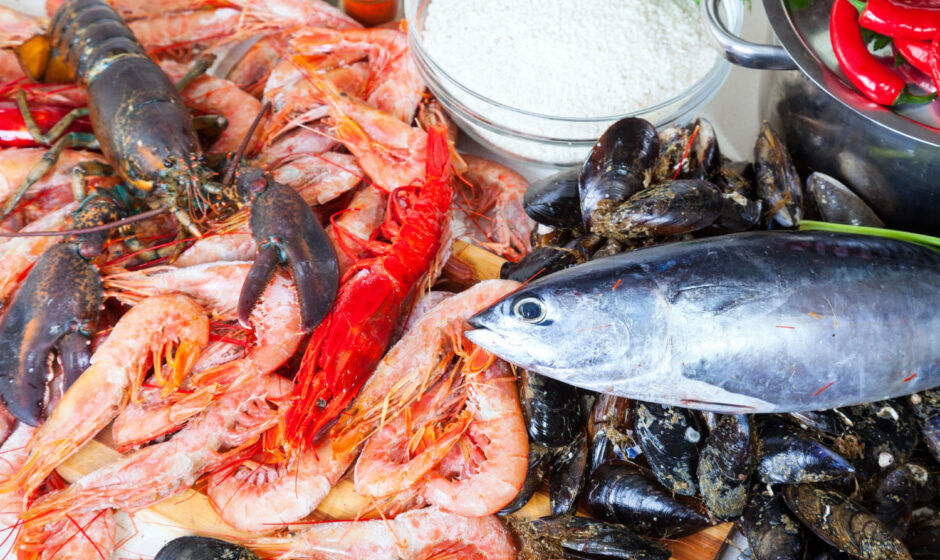Executive Summary:
This report analyzes the potential for seafood exports from India to the UK over the period 2024-2030. It identifies key market trends, opportunities, and challenges, providing valuable insights for businesses and stakeholders in both countries.
Market Overview:
- The UK is a significant importer of seafood, with annual imports exceeding USD 14 billion.
- India has emerged as a major seafood exporter, with exports exceeding USD 9 billion in 2023.
- India currently holds a 3% share of the UK’s seafood import market, presenting significant growth potential.
Market Drivers:
- Growing UK Seafood Demand: Rising disposable incomes and increasing health awareness are fueling demand for seafood in the UK.
- Brexit: The UK’s exit from the European Union has opened doors for new trade partnerships, including with India.
- Competitive Prices: Indian seafood is known for its competitive pricing, making it attractive to UK importers.
- Diversification of Seafood Sources: UK buyers are seeking to diversify their seafood sources to reduce dependence on traditional suppliers.
Current Product Mix:
The major types of seafood products exported from India to the UK include:
- Crustaceans: Shrimp and prawns are the dominant category, accounting for over 50% of total seafood exports. This includes frozen, cooked, peeled, and deveined varieties.
- Fish: Whitefish species like cod, haddock, and pollock hold a significant share, followed by fatty fish like salmon and tuna.
- Mollusca: Squid, cuttlefish, and octopus are exported in frozen and processed forms.
- Others: A small portion comprises products like fish roe, marine mammals, and seaweed.
Market Opportunities:
- Increased Demand for Specific Products: The UK market presents a strong demand for specific seafood products, including shrimp, prawns, and whitefish.
- Value-Added Products: Growing demand for value-added seafood products, such as ready-to-eat meals and frozen seafood, offers opportunities for Indian exporters.
- Direct Sourcing: Establishing direct sourcing relationships with UK importers can help Indian exporters gain greater market access and control over pricing.
Market Challenges:
- Non-Tariff Barriers: Stringent UK regulations regarding food safety and traceability pose challenges for Indian exporters.
- Competition: India faces competition from established seafood exporters like Norway, Iceland, and Vietnam.
- Logistics and Infrastructure: Efficient logistics and infrastructure are crucial for maintaining product quality and ensuring timely delivery to the UK market.
Market Projections:
- Overall Growth: The Indian seafood export market to the UK is projected to grow at a CAGR of 5-7% during the period 2024-2030.
- Value Growth: By 2030, Indian seafood exports to the UK are expected to reach a value of USD 2.5-3 billion.
- Product Categories: Shrimp and prawns are expected to remain the leading export categories, followed by whitefish and value-added products.
The overall value of Indian seafood exports to the UK is expected to grow at a CAGR of 5-7% during the period 2024-2030. This translates to:
- Total Value: Reaching USD 2.5-3 billion by 2030.
- Product-Specific Growth:
- Crustaceans: Projected growth of 6-8%, with shrimp and prawns remaining the major exports.
- Fish: Projected growth of 4-6%, with increasing demand for whitefish species.
- Mollusca: Projected growth of 5-7%, fueled by rising demand for squid and octopus.
- Others: Expected to maintain a small but consistent share of the market.
Emerging Trends:
- Value-Added Products: Ready-to-eat meals, marinated seafood, and pre-portioned products are gaining traction.
- Sustainability: Consumers are increasingly interested in sustainably sourced seafood, creating opportunities for certified Indian exports.
- Organic Seafood: A niche market with growing demand for organic shrimp and fish.
- Plant-Based Alternatives: Plant-based substitutes for seafood are emerging as potential future players.
Key Success Factors:
- Meeting UK Regulations: Ensuring compliance with UK regulations and obtaining relevant certifications is crucial for market entry.
- Quality Control: Maintaining high quality standards throughout the supply chain is essential for gaining market acceptance.
- Investment in Branding and Marketing: Building brand awareness and promoting Indian seafood in the UK market is important for long-term success.
- Logistics and Infrastructure Development: Investing in efficient logistics and infrastructure is crucial for ensuring timely and cost-effective delivery.
Conclusion:
The Indian seafood export market to the UK presents significant growth potential due to rising demand, Brexit-related opportunities, and competitive pricing advantages. However, navigating non-tariff barriers, competition, and logistical challenges will be essential for Indian exporters to capitalize on this market potential. Through strategic planning, quality control, and focused marketing efforts, Indian seafood exporters can gain a strong foothold in the UK market and contribute to the growth of the Indian seafood industry.
Methodology:
This market research report is based on data collected from various sources, including:
- Government reports and databases: Department for International Trade (UK), Marine Products Export Development Authority (India)
- Industry reports and publications: SeafoodSource, The Fish Site, Seafood Business
- Market research reports: Statista, Euromonitor International, Transparency Market Research
- News articles and industry journals
Disclaimer:
This market research report is intended for informational purposes only and should not be construed as financial advice. The information presented in this report is based on the best available information at the time of publication and may be subject to change without notice.

